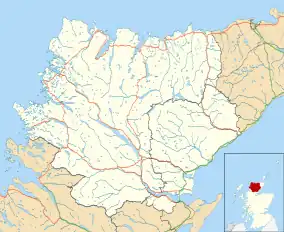Lochinver
Lochinver (Loch an Inbhir in Gaelic) is a village that is located at the head of the sea loch Loch Inver, on the coast in the Assynt district of Sutherland, Highland, Scotland.[2] A few miles northeast is Loch Assynt which is the source of the River Inver which flows into Loch Inver at the village. There are 200 or so lochans in the area which makes the place very popular with anglers. Lochinver is dominated by the "sugar loaf" shape of Caisteal Liath, the summit peak of nearby Suilven.
Lochinver
| |
|---|---|
| Village | |
 Lochinver Location within the Sutherland area | |
| Population | 651 (2011)[1] |
| Council area | |
| Lieutenancy area | |
| Country | Scotland |
| Sovereign state | United Kingdom |
| Post town | Lairg |
| Postcode district | IV27 |
| Dialling code | 01571 |
| Police | Scotland |
| Fire | Scottish |
| Ambulance | Scottish |
| UK Parliament | |
| Scottish Parliament |
|
Fishing port
Lochinver is an important fishing port in Scotland; frequented by European fishermen primarily from Spain and France. Lochinver underwent a major renewal project in the 1990s where the harbour area was rebuilt and a new and much improved loading area was created. This new development involved blasting an area of several hectares out of the surrounding rock.
In 2020, Lochinver was the fourth largest whitefish (demersal) port, with over £14 million of fish and shellfish passing through the port (of which £1.6 million was landed by Scottish vessels).[3]
The back of Lochinver is a beautiful part of Assynt with local tourism and nature areas being developed in conjunction with small-scale forestry activities. Birdlife in Lochinver includes the curlew, oystercatcher and hooded crow.
Local villages
Other local villages include Inverkirkaig, accessed by the road leading up the River Culag, and on the coastal road north: Achmelvich, Clachtoll, Clashmore, Stoer, Clashnessie, Drumbeg and Culkein Drumbeg.
Proposed railway link
In the 1890s, it was suggested that a railway be constructed from Invershin to Lochinver, to 'open up' the Highlands and provide a direct rail connection with ferries to the Western Isles. This scheme was an alternative to a proposed route to Ullapool from Garve. In the event, neither were able to obtain funding.[4]
Other places named Lochinver
The Lochinver name was adopted in the 1950s by a large (35,000-acre or 14,000-hectare) sheep station in New Zealand's North Island.
Lochinver in film
- 1973 - The Highlands and Islands - A Royal Tour, a documentary about Prince Charles' visit to the Highlands and Islands, directed by Oscar Marzaroli.[5]
- 2017 - Edie, a film about a widowed pensioner who climbs Suilven, directed by Simon Hunter.[6]
Education
Lochinver has a primary School[7] situated on the banks of Loch Culag. It serves the village of Lochinver as well as the outlying areas of Achmelvich to the north, Inverkirkaig to the south and Elphin to the east. The school is housed in the old village school which has been extended over the years.
For High School age pupils, a daily bus service takes them some 36 miles in each direction to the neighbouring village of Ullapool and back.
Churches
The village of Lochinver has three churches, The Church of Scotland,[8] The Free Church[9] and The Free Presbyterian Church.[10] The Free Presbyterian Church no longer has services on a Sunday and locals who wish to attend have to drive 34 miles to Ullapool.


The White Shore
The beautiful White Shore is so-called for its gneiss and quartzite pebbles[3]. Is location a miles walk from one of two access point, one[4] from the peir, and the other at the head of Loch Culag locally know as the School Loch. The stone beach is surrounded by the Culag Woods which is managed by the Culag Community Woodland Trust (CCWT).

The Culag Woods
Overlooking Lochinver, a 40-hectare (99 acres) woodland area provides a picturesque blend of forested and coastal vistas punctuated by the iconic Suilven peak.
In 1847, George Cranwell, the second duke and twentieth earl of Sutherland, established the paths and planted the trees that became known as the Culag woods. Today however, and since 1995, Culag Community Woodland Trust (CCWT) oversees Culag Wood under a fifty-year lease from Assynt Estates and Highland Council and owns the Little Assynt Estate acquired in 2000. In 2003, the Trust purchased an office to enhance administration and outreach to locals, visitors, and partner organisations.


Gallery



References
- "POPULATION CHANGE IN CAITHNESS AND SUTHERLAND 2001 TO 2011". Highland Council. 11 February 2014. Archived from the original on 13 January 2017. Retrieved 11 February 2011.
- Gittings, Bruce; Munro, David. "Lochinver". The Gazetteer for Scotland. School of GeoSciences, University of Edinburgh and The Royal Scottish Geographical Society. Retrieved 7 June 2019.
- "Scottish Sea Fisheries Statistics 2020". Scottish Sea Fisheries Statistics. Scottish Government. 21 September 2021. Retrieved 17 November 2021.
- "Garve and Ullapool Railway Bill: Second Reading". Parliamentary Debates (Hansard). 31 May 1892. col. 349–351. Retrieved 29 September 2012.
{{cite book}}:|work=ignored (help) - "Full record for 'HIGHLANDS AND ISLANDS - A ROYAL TOUR'" Scottish Screen Archive. Retrieved 21 June 2010.
- "EDIE Screens first in the village of Lochinver" Simon Hunter Official website. Retrieved 28 April 2020.
- Thornton, Matt. "Lochinver Primary". www.highland.gov.uk. Retrieved 25 September 2023.
- Scotland, The Church of (4 July 2022). "Fascinating history of Sutherland church brought to life". The Church of Scotland. Retrieved 25 September 2023.
- "Assynt & Eddrachillis (Lochinver)". FCC. Retrieved 25 September 2023.
- "Ullapool and Lochinver Congregation – Free Presbyterian Church of Scotland". www.fpchurch.org.uk. Retrieved 25 September 2023.



